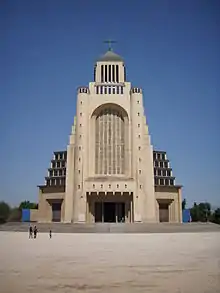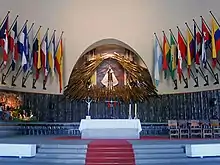Votive Temple of Maipú
The Votive Temple of Maipú (in Spanish: Templo Votivo de Maipú) or Basilica of Our Lady of Mount Carmel (in Spanish: Basílica de Nuestra Señora del Carmen) is a Catholic temple located in the Chilean town of Maipú. Its construction was ordered by Bernardo O'Higgins on 1818 as an act of thanksgiving to Our Lady of Mount Carmel for the intercession for the victory of the Chilean Army in the Battle of Maipú, where the Independence of Chile was assured. It's called Votive because of the votes (a kind of promise) that O'Higgins made for the Virgin Mary.

History
After its construction was decreed on May 7, 1818,[1] on November 15 of the same year the first stone of the Victory Chapel or Votive Church of Maipú was laid and blessed. After 64 years of intermittent construction due to lack of resources, the old Church was solemnly inaugurated. But in 1906, a violent earthquake made the reconstruction of the temple necessary. On December 8, 1942, the Marian congress that was held in Santiago, took as the only agreement of this meeting to build a great sanctuary in Maipú, on the grounds of the old Chapel of Victory to honor Our Lady of Mount Carmel.[2]
This is how on July 16, 1948, the Archbishop of Santiago Monsignor José María Caro ordered the construction of the new sanctuary. During the long years of the construction of the current temple, Catholic groups such as Iglesia Joven or Clandestina, opposed it because they described it as a luxury, proposing to deliver the money invested in it to the poorest people, both of the Archdiocese of Santiago and the rest from the country. The work was delayed due to lack of resources but finally on October 24, 1974, and thanks to the O'Higgins National Vote Foundation (on which the Sanctuary depends today), the Votive Temple of Maipú was solemnly inaugurated.
Initially, the project was conceived to transform this place into a large mausoleum where the remains of the Heroes of the Homeland and the most notable Chileans rest, similar to the Pantheon in Paris, but the Church opposed this initiative and preferred to transform it into a Shrine, dedicated exclusively to Catholic worship and spiritual care of pilgrims.
On November 23, 1974, the Bishops of Chile, chaired by Cardinal Archbishop of Santiago Monsignor Raúl Silva Henríquez consecrated the temple.[3] On October 26, 1984 the temple was declared historical monument by the Supreme Decree No. 645.[4] On January 27, 1987, the temple was declared as Basilica.
The image

The image of Our Lady of Mount Carmel, venerated in the Temple, is a sculpture of wood brought to Chile in 1785 by Martín de Lecuna for his oratory. The image was donated to the Cardinal Archbishop of Santiago, Mons. José María Caro by Mrs. Rosalía Mujica de Gutiérrez, a descendant of Don Martín de Lecuna, in August 1945.
On April 3, 1987, the image was crowned as Queen and Patroness of Chile by Pope John Paul II when he was making an apostolic visit to Chile, ratifying the decree of Pope Pius XI in 1923 that granted such distinction.
Viewpoint
Just below the bell tower of the temple (63 m/206 ft high) there is a viewpoint. This space was inaugurated on April 3, 2012, coinciding with the twenty-fifth anniversary of the visit of John Paul II to Chile. With an area of 300 m²/3229 ft², this place offers a panoramic view of Santiago's southwest sector. It can be accessed by elevator or by a staircase of 323 steps. The viewpoint has audiovisual equipment to display informative content to visitors, in addition, inside there is a Compass rose that indicates the location of various Marian sanctuaries in the world.[5]
References
- "Orígenes de la comuna de Maipú" (in Spanish). Maipú: Municipality of Maipú. Archived from the original on October 2, 2010. Retrieved September 9, 2019.
- "Santuario Templo Votivo Nacional de Maipú" (in Spanish). Santiago: Archdiocese of Santiago. Retrieved September 9, 2019.
- ""Constructores de la sociedad" reciben simbólico envío desde Maipú" (in Spanish). Santiago: Bishops' Conference of Chile. November 21, 2004. Retrieved September 9, 2019.
- "Templo votivo nacional" (in Spanish). Santiago: Council of National Monuments of Chile. Retrieved September 9, 2019.
- González, María Francisca (July 15, 2018). "El Templo Votivo de Maipú a 200 años de su primera piedra" (in Spanish). ArchDaily. Retrieved September 9, 2019.
External links
| Wikimedia Commons has media related to Templo Votivo de Maipú. |
- Official website (in Spanish)
- Information about the sanctuary (in Spanish)